Entrepreneurial Innovation Impact on Recycling Municipal Waste. A Panel Data Analysis at the EU Level
Abstract
1. Introduction
2. Materials and Methods
2.1. Research Methodology
2.2. Description of the Entrepreneurial Innovation and Recycling at the EU Level
- Use of the “waste = food” approach to help recover waste materials, to make sure that biological materials could be reused at the end of their life;
- Extend the life of product and materials, if possible, over multiple “cycles”;
- Conserve or regenerate living systems and nature;
- Retain the water, the embedded energy, and other inputs in the material and product for as long as possible;
- Push for taxes, market mechanisms, and policies that encourage “polluter pays” regulations.
3. Results
- (i)
- Restricted model:
- (ii)
- Unrestricted model: .
- H0: ;
- H1: ;
- Y = recycling rate of municipal waste;
- X1 = business expenditures on R&D;
- X2 = private investments, jobs, and gross added value related to the recycling sector;
- X3 = GDP on R&D by the business enterprise sector;
- X4 = resource productivity;
- X5 = environmental taxes.
4. Discussion
5. Conclusions
Author Contributions
Funding
Acknowledgments
Conflicts of Interest
Abbreviations
| EU | European Union |
| R&D | Research and development |
| GDP | Gross domestic product |
| RRMW | Recycling rate of municipal waste |
| MSW | Municipal solid waste |
| EUROSTAT | Statistical Office of the European Union |
| DMC | Domestic material consumption |
| PLS | Pooled least square |
| OLS | Ordinal least square |
| GERD | Gross domestic expenditure on R&D |
| UK | United Kingdom |
References
- Amman, T.S.; Haffar, J.M.; Ghoneim, A.; Arabiyat, O. The influence of institutional and conductive aspects on entrepreneurial innovation Evidence from GEM data. J. Enterp. Inf. Manag. 2019, 32, 366–389. [Google Scholar]
- Ignat, R. Premises and challenges of entrepreneurship in Romanian rural areas. Econ. Ser. Manag. 2012, 15, 423–435. [Google Scholar]
- Błazejowski, M.; Kwiatkowski, J.; Gazda, J. Sources of economic growth: A global perspective. Sustainability 2019, 11, 275. [Google Scholar] [CrossRef]
- Roşca, V. Sustainable development of a city by using a football club. Theor. Empir. Res. Urban Manag. 2010, 5, 61–68. [Google Scholar]
- Schumpeter, J.A. The Theory of Economic Development; Harvard University Press: Cambridge, UK, 1934. [Google Scholar]
- Nooteboom, B.; Stam, E. Micro-Foundations for Innovation Policy, Chapter: Entrepreneurship and Innovation; Amsterdam University Press: Amsterdam, The Netherlands, 2008. [Google Scholar]
- Thurik, R.; Wennekers, S. Linking entrepreneurship and economic growth. Small Bus. Econ. 1999, 13, 27–56. [Google Scholar]
- Zhao, F. Exploring the synergy between entrepreneurship and innovation. Int. J. Entrep. Behav. Res. 2005, 11, 25–41. [Google Scholar] [CrossRef]
- Kralj, D. Innovative systemic approach for promoting sustainable innovation for zero construction waste. Kybernetes 2011, 40, 275–289. [Google Scholar] [CrossRef]
- Venkateswaran, S. Managing waste: Ecological, economic and social dimensions. Econ. Political Wkly. 1994, 29, 2907–2911. [Google Scholar]
- Callan, S.J.; Thomas, J.M. Economies of Scale and Scope: A Cost Analysis of Municipal Solid Waste Services; University of Wisconsin Press: Madison, WI, USA, 2001; Volume 77, pp. 548–560. [Google Scholar]
- Kang, J.; Lin, J.; Zhao, X.; Zhao, S.; Kou, L. Decomposition of the urban water footprint of food consumption: A case study of Xiamen City. Sustainability 2017, 9, 135. [Google Scholar] [CrossRef]
- Johnstone, N.; Labonne, J. Generation of Household Solid Waste in OECD Countries: An Empirical Analysis Using Macroeconomic Data; University of Wisconsin Press: Madison, WI, USA, 2004; Volume 80, pp. 529–538. [Google Scholar]
- Trica, C.L. Eco-Entrepreneurial Development in the Rural Environmental Area, Rural Communities in the Global Economy, Beyond the Classical Rural Economy Paradigms; Istudor, N., de Los Rios, I., Andrei, J.-V., Eds.; Nova Science Publishers: Hauppauge, NY, USA, 2017; ISBN 978-1-53610-255-0. [Google Scholar]
- Grant, R. E-waste challenges in Cape Town Opportunity for the green economy? In Urban and Spatial Challenges in South Africa: Continuing The Conversation; Izziv, U., Ed.; Urbanistični inštitut Republike Slovenije: Ljubljana, Slovenije, 2019; Volume 30, pp. 5–23. [Google Scholar]
- Rode, S. E-Waste Management in Mumbai Metropolitan Region: Constraints and Opportunities, Theoretical and Empirical Researches in Urban Management; Research Center in Public Administration and Public Services: Bucharest, Romania, 2012; Volume 7, pp. 89–103. [Google Scholar]
- Borrello, M.; Caracciolo, F.; Lombardi, A.; Pascucci, S.; Cembalo, L. Consumers’ perspective on circular economy strategy for reducing food waste. Sustainability 2017, 9, 141. [Google Scholar] [CrossRef]
- Zhai, Y.-M.; Sun, W.-Q.; Tsai, S.-B.; Wang, Z.; Zhao, Y.; Chen, Q. An empirical study on entrepreneurial orientation, absorptive capacity, and SMEs’ innovation performance: A sustainable perspective. Sustainability 2018, 10, 314. [Google Scholar] [CrossRef]
- Pargaru, I.; Dinu, M.; Teodor, C. Review and prospects of environmental problems in the city of Bucharest. Qual. Access Success 2017, 18, 302–306. [Google Scholar]
- Fletcher, M.; Loane, S.; Rahman, M.; Fatima, N. Entrepreneurship and urban growth: Dimensions and empirical models. J. Small Bus. Enterp. Dev. 2011, 18, 608–626. [Google Scholar]
- Ghura, H.; Li, X.; Harraf, A. Moderating relationship of institutions for opportunity entrepreneurship and economic development. World J. Entrep. Manag. Sustain. Dev. 2013, 13, 350–374. [Google Scholar] [CrossRef]
- Trica, C.L.; Banacu, C.S.; Busu, M. Environmental factors and sustainability of the circular economy model at the European Union level. Sustainability 2018, 11, 1114. [Google Scholar] [CrossRef]
- Weerawardena, J.; Coote, L. An empirical investigation into entrepreneurship and organizational innovation-based competitive strategy. J. Res. Mark. Entrep. 2001, 3, 51–70. [Google Scholar] [CrossRef]
- Mocanu, M.; Ciurea, C. Developing an index score for the internal auditor profile in Romania based on real data analysis. Econ. Comput. Econ. Cybern. Stud. Res. 2019, 53, 93–111. [Google Scholar] [CrossRef]
- Woodside, A.; Mir Bernal, P.; Coduras, A.; Woodside, A. Constructing cased-based macro models: Cultures’ consequences on entrepreneurship, innovation, and quality-of-life. In Case Study Research: Core Skill Sets in Using 15 Genres; Emerald Group Publishing Limited: Bingley, UK, 2016; pp. 433–488. [Google Scholar]
- Farinha, L.; Ferreira, J.; Nunes, S. Linking innovation and entrepreneurship to economic growth. Compet. Rev. 2018, 28, 451–475. [Google Scholar] [CrossRef]
- Dobrea, R.; Molănescu, G.; Buṣu, C. Food Sustainable Model Development: An ANP Approach to Prioritize Sustainable Factors in the Romanian Natural Soft Drinks Industry Context. Sustainability 2015, 7, 10007–10020. [Google Scholar] [CrossRef]
- Mourad, M. Recycling, recovering and preventing “food waste”: Competing solutions for food systems sustainability in the United States and France. J. Clean. Prod. 2016, 126, 461–477. [Google Scholar] [CrossRef]
- Yabar, H.; Uwasu, M.; Hara, K. Tracking environmental innovations and policy regulations in Japan: Case studies on dioxin emissions and electric home appliances recycling. J. Clean. Prod. 2013, 44, 152–158. [Google Scholar] [CrossRef]
- Nemat, B.; Razzaghi, M.; Bolton, K.; Rousta, K. The role of food packaging design in consumer recycling behavior—A literature review. Sustainability 2019, 11, 4350. [Google Scholar] [CrossRef]
- Jabłońska, B.; Kiełbasa, P.; Korenko, M.; Dróżdż, T. Physical and chemical properties of waste from PET bottles washing as a component of solid fuels. Energies 2019, 12, 2197. [Google Scholar] [CrossRef]
- Paunov, C. The global crisis and firms’ investments in innovation. Res. Policy 2012, 41, 24–35. [Google Scholar] [CrossRef]
- Caniato, F.; Caridi, M.; Crippa, L.; Moretto, A. Environmental sustainability in fashion supply chains: An exploratory case-based research. Int. J. Prod. Econ. 2012, 135, 659–670. [Google Scholar] [CrossRef]
- Dangelico, R.M.; Pujari, D. Mainstreaming green product innovation: Why and how companies integrate environmental sustainability. J. Bus. Ethics 2010, 95, 471–486. [Google Scholar] [CrossRef]
- Horbach, J.; Rennings, K. Environmental innovation and employment dynamics in different technology fields—An analysis based on the German Community Innovation Survey 2009. J. Clean. Prod. 2013, 57, 158–165. [Google Scholar] [CrossRef]
- da Cruz, N.F.; Simões, P.; Marques, R.C. Economic cost recovery in the recycling of packaging waste: The case of Portugal. J. Clean. Prod. 2012, 37, 8–18. [Google Scholar] [CrossRef]
- Busu, M. Adopting circular economy at the European Union Level and its impact on economic growth. Soc. Sci. 2019, 8, 159. [Google Scholar] [CrossRef]
- Weetman, C. A Circular Economy Handbook for Business and Supply Chains: Repair, Remake, Redesign, Rethink; Kogan Page Publishers: London, UK, 2016; ISBN 13 078-0749476755. [Google Scholar]
- Eurostat. Your Key to European Statistics. 2017. Available online: http://ec.europa.eu/eurostat (accessed on 24 June 2019).
- Hozo, S.P.; Djulbegovic, B.; Hozo, I. Estimating the mean and variance from the median, range, and the size of a sample. BMC Med Res. Methodol. 2005, 5, 13. [Google Scholar] [CrossRef]
- Dabholkar, P.A.; Shepherd, C.D.; Thorpe, D.I. A comprehensive framework for service quality: An investigation of critical conceptual and measurement issues through a longitudinal study. J. Retail. 2000, 76, 139–173. [Google Scholar] [CrossRef]
- Schmidheiny, K. Panel Data: Fixed and Random Effects. Basel Universität, 2016. Available online: http://www.schmidheiny.name/teaching/panel2up.pdf (accessed on 18 July 2019).
- Block, J. Long-Term Orientation of Family Firms: An Investigation of R&D Investments, Downsizing Practices, and Executive Pay; Gabler: Wiesbaden, Germany, 2009; Available online: https://link.springer.com/book/10.1007/978-3-8349-8412-8 (accessed on 18 August 2019).
- Rada, E.C.; Zatelli, C.; Cioca, L.I.; Torretta, V. Selective collection quality index for municipal solid waste management. Sustainability 2018, 10, 257. [Google Scholar] [CrossRef]
- Rada, E.C.; Bresciani, C.; Girelli, E.; Ragazzi, M.; Schiavon, M.; Torretta, V. Analysis and measures to improve waste management in schools. Sustainability 2016, 8, 840. [Google Scholar] [CrossRef]
- Bell, J.; Paula, L.; Dodd, T.; Nemeth, S.; Nanou, C.; Mega, V.; Campos, P. EU ambition to build the world’s leading bioeconomy—Uncertain times demand innovative and sustainable solutions. New Biotechnol. 2018, 40, 25–30. [Google Scholar] [CrossRef] [PubMed]
- Silva, A.; Rosano, M.; Stocker, L.; Gorissen, L. From waste to sustainable materials management: Three case studies of the transition journey. Waste Manag. 2017, 61, 547–557. [Google Scholar] [CrossRef] [PubMed]
- Troschinetz, A.M.; Mihelcic, J.R. Sustainable recycling of municipal solid waste in developing countries. Waste Manag. 2009, 29, 915–923. [Google Scholar] [CrossRef] [PubMed]
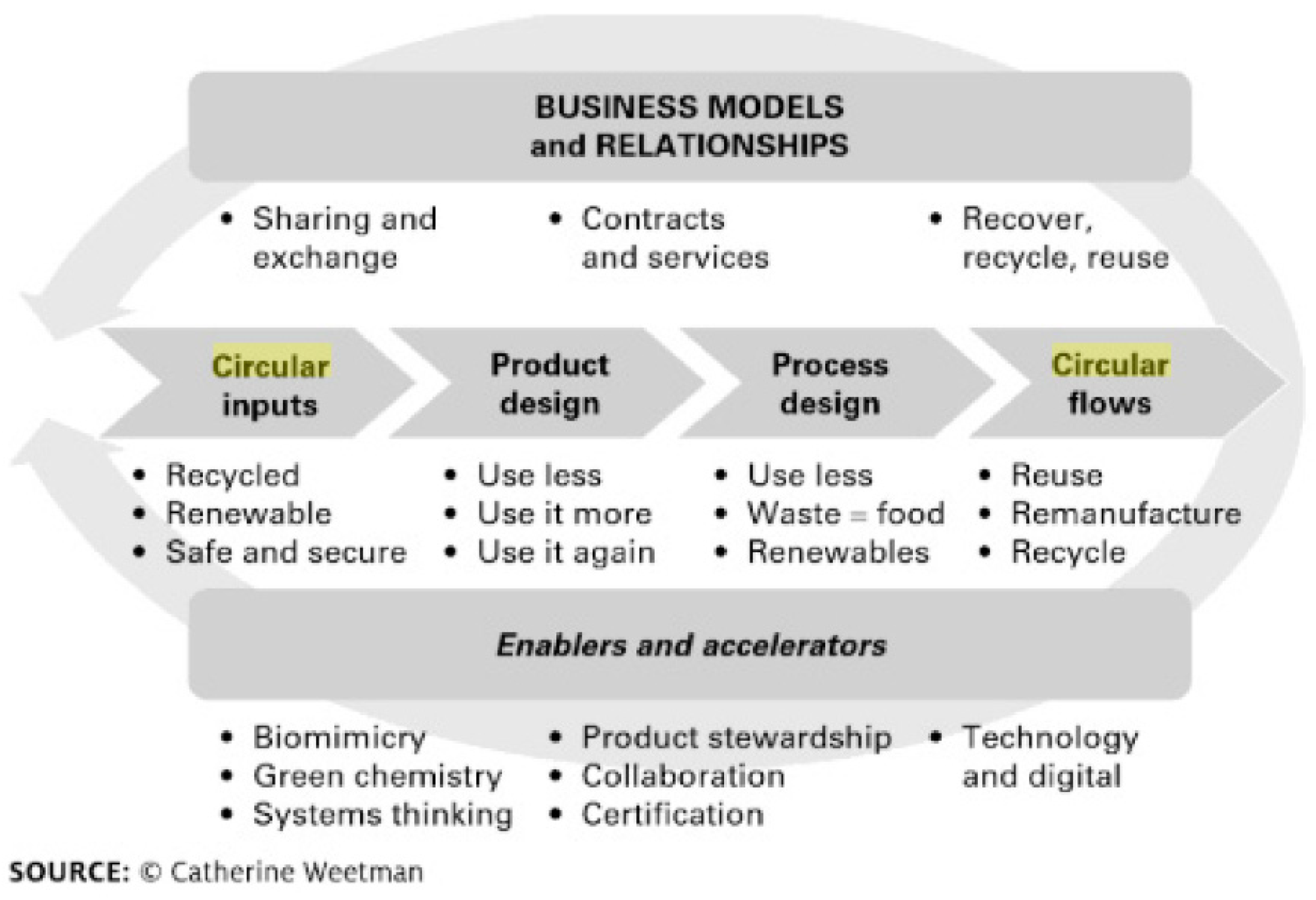
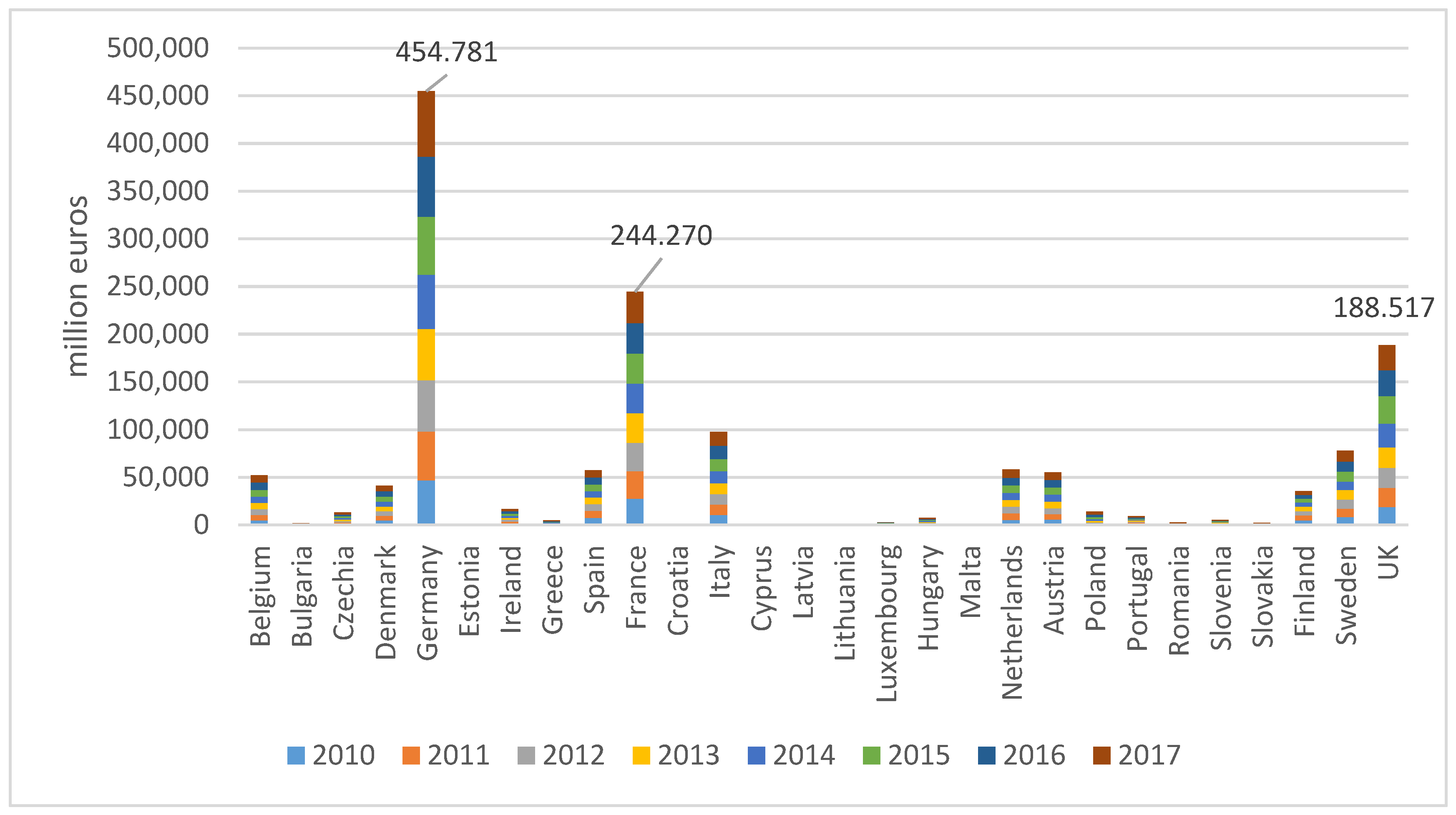
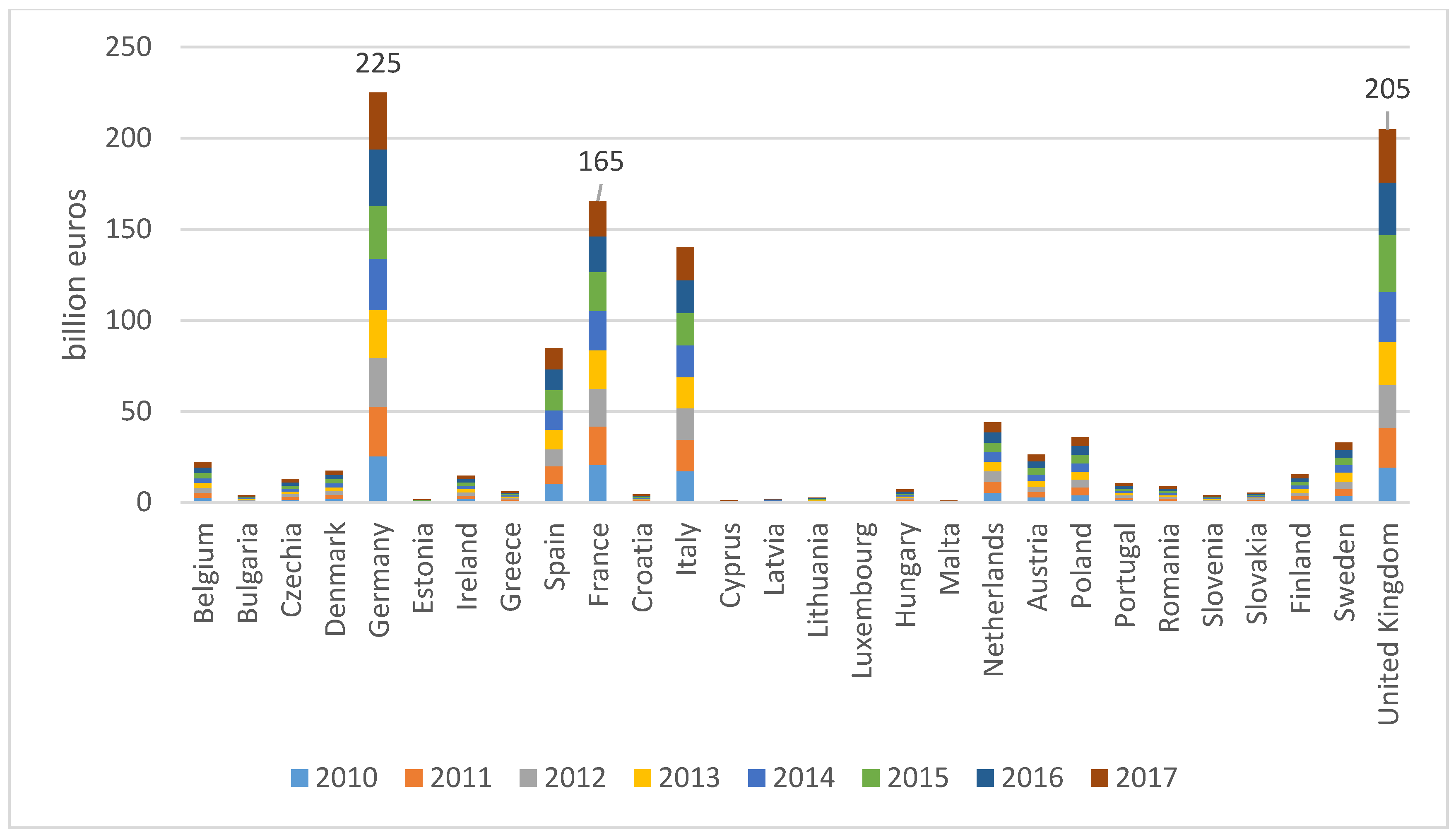
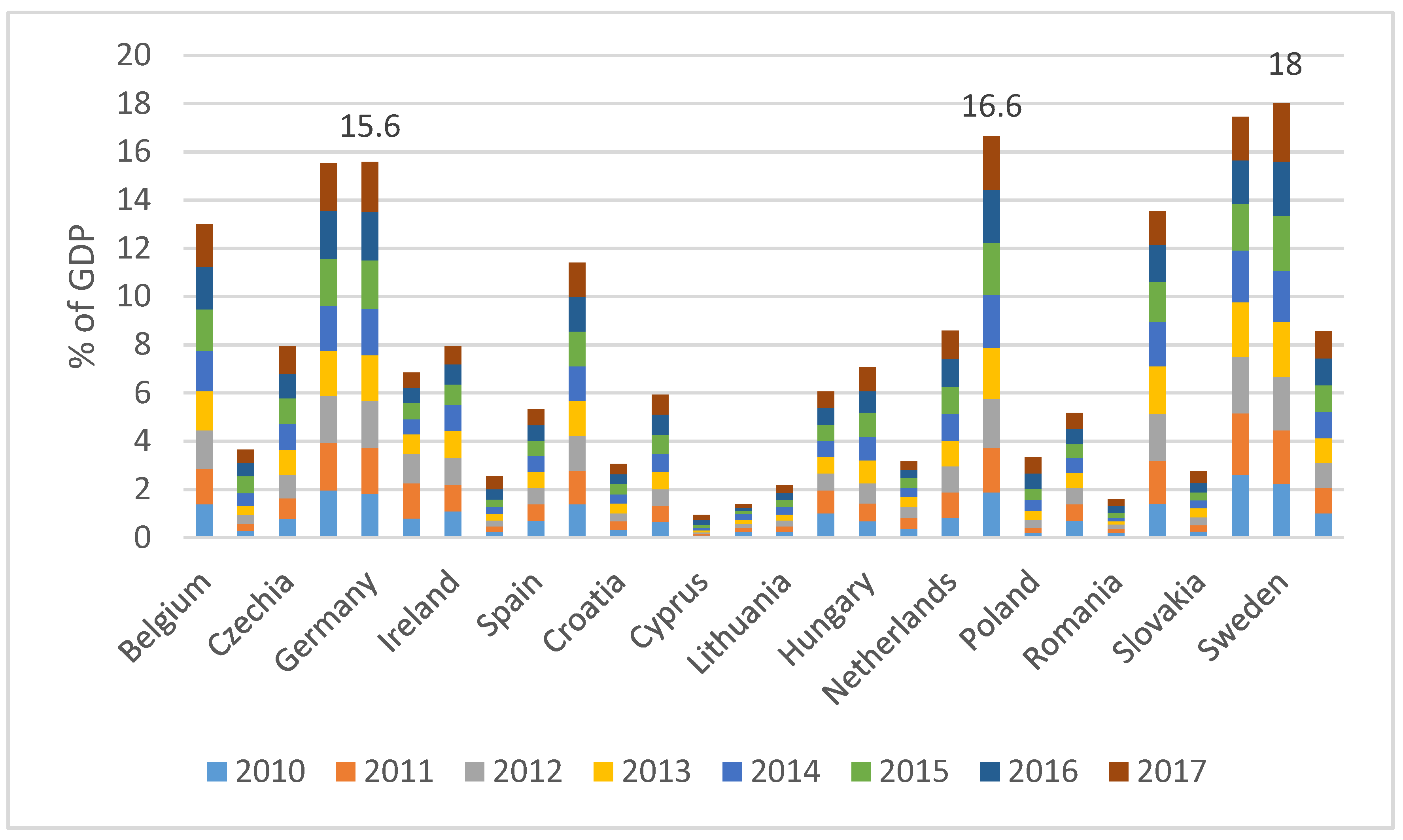
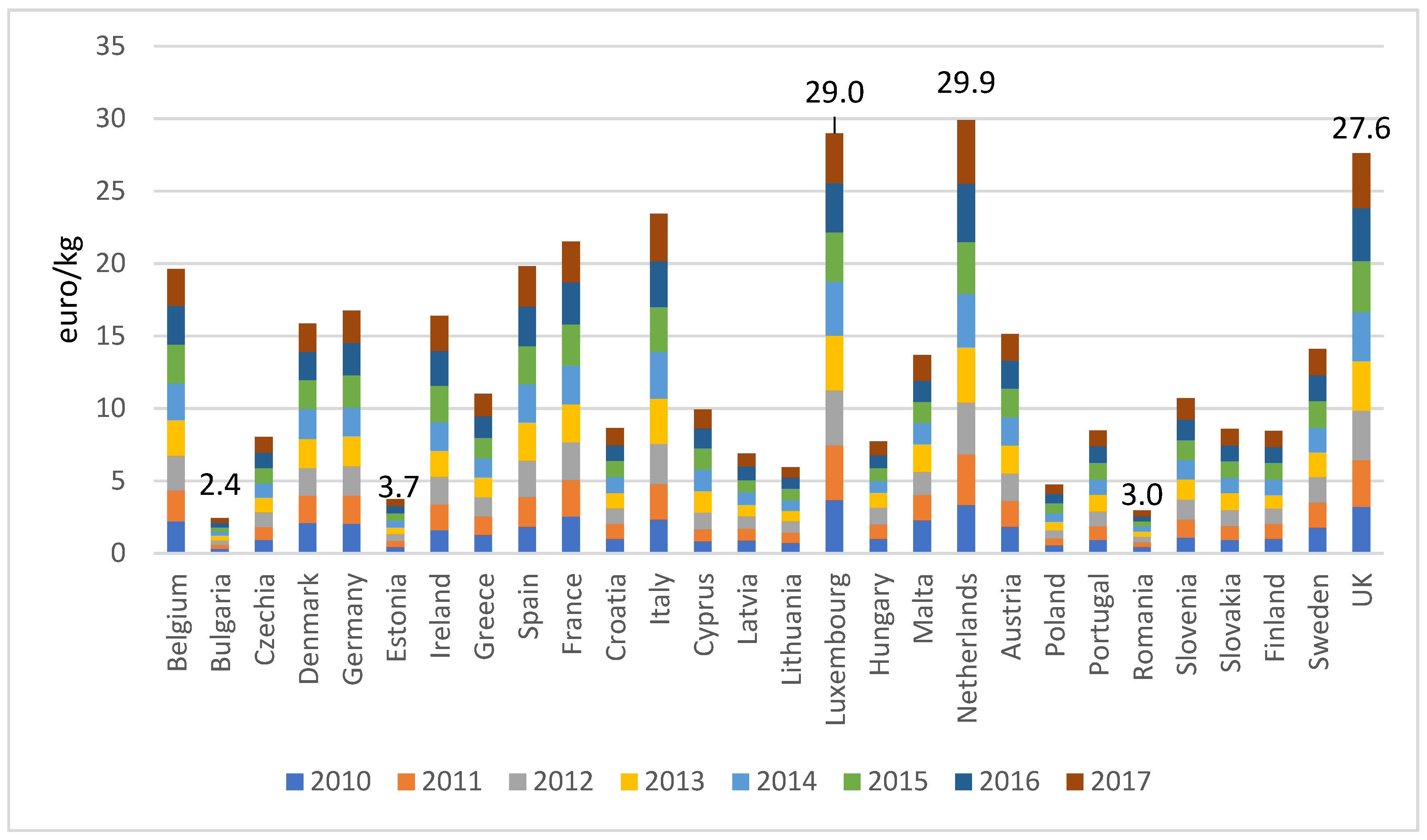
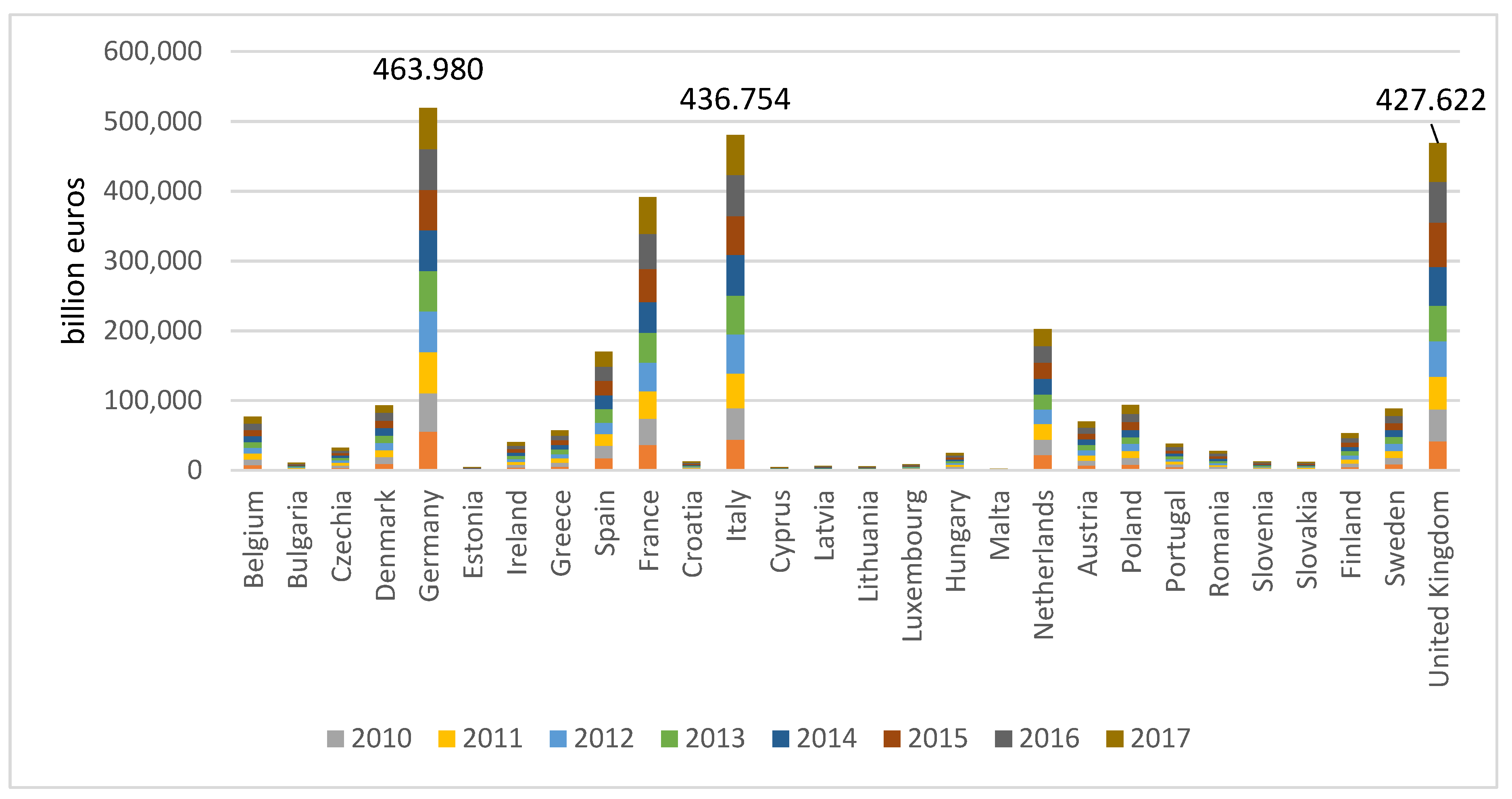
| H1 | Business expenditures on R&D at the EU level have a positive impact on the RRMW. |
| H2 | Private investments are strongly correlated with RRMW at the EU level. |
| H3 | GDP expenditures on R&D by the business enterprise sector have a positive impact on the RRMW in EU member states |
| H4 | Resource productivity has a positive impact on the RRMW in EU countries |
| H5 | Environmental taxes have a significant impact on the RRMW at the EU level |
| Variable | Unit | Min | Mean | Median | Max | St. Dev. | N |
|---|---|---|---|---|---|---|---|
| RRMW (Y) | % | 6.400 | 37.178 | 34.800 | 67.600 | 14.882 | 27 |
| Business expend. (X1) | Mill. euros | 38 | 7.741 | 7.800 | 68.644 | 12.340 | 27 |
| Private (X2) | Bill. euros | 0.200 | 6.200 | 6.400 | 31.200 | 4.326 | 27 |
| GERD (X3) | % | 0.14 | 0.786 | 0.710 | 2.42 | 0.123 | 27 |
| Res_prod (X4) | Euro/kg | 0.300 | 2.123 | 2.100 | 4.400 | 0.789 | 27 |
| Environ tax(X5) | Bill. euros | 0.303 | 8.171 | 7.895 | 59.259 | 8.930 | 27 |
| Variable | X1 | X2 | X3 | X4 | X5 |
|---|---|---|---|---|---|
| X1 | 1 | ||||
| X2 | 0.113 | 1 | |||
| X3 | 0.125 | 0.137 | 1 | ||
| X4 | 0.207 | 0.205 | 0.149 | 1 | |
| X5 | 0.198 | 0.278 | 0.098 | 0.101 | 1 |
| F-Statistic | 3.48 |
| Probability | 0.190 |
| Cross Section | Time | Both | |
|---|---|---|---|
| Coeff. | 29.13 | 52.28 | 82.48 |
| Prob. | 0.091 | 0.583 | 0.036 |
| Dependent Variable: RRMW | ||||
| Method: Pooled Least Square | ||||
| Sample: 2010–2017 | ||||
| Total panel observations: 216 RRMW = B(0) + B(1) × BUSINESS_EXPEND + B(2) × PRIVATE + B(3) × GERD + B(4) × RES_PROD + B(5) × ENVIRON_TAX | ||||
| Coefficient | Std. Error | t-Statistic | Prob. | |
| C | −2.23786 | 1.165 | 4.298750 | 0.0009 |
| BUSINESS_EXPEND | 0.658946 | 1.235 | 3.674397 | 0.0023 |
| PRIVATE | 0.764987 | 1.414 | 4.096785 | 0.0019 |
| GERD | 0.385684 | 1.152 | 2.673098 | 0.0175 |
| RES_PROD | 0.276856 | 1.167 | 1.987658 | 0.0210 |
| ENVIRON_TAX | −0.187912 | 1.725 | 1.678934 | 0.0421 |
| R-squared | 0.729867 | Mean dependent var | 7.6882 | |
| Adjusted R-squared | 0.684598 | S.D. dependent var | 0.9876 | |
| S.E. of regression | 0.198763 | Akaike info criterion | 1.9287 | |
| Sum squared resid. | 1.765487 | Schwarz criterion | 1.8035 | |
| Log likelihood | 112.7623 | Hannan–Quinn criter. | 1.7036 | |
| Durbin–Watson stat | 2.060983 | |||
© 2019 by the authors. Licensee MDPI, Basel, Switzerland. This article is an open access article distributed under the terms and conditions of the Creative Commons Attribution (CC BY) license (http://creativecommons.org/licenses/by/4.0/).
Share and Cite
Banacu, C.S.; Busu, M.; Ignat, R.; Trica, C.L. Entrepreneurial Innovation Impact on Recycling Municipal Waste. A Panel Data Analysis at the EU Level. Sustainability 2019, 11, 5125. https://doi.org/10.3390/su11185125
Banacu CS, Busu M, Ignat R, Trica CL. Entrepreneurial Innovation Impact on Recycling Municipal Waste. A Panel Data Analysis at the EU Level. Sustainability. 2019; 11(18):5125. https://doi.org/10.3390/su11185125
Chicago/Turabian StyleBanacu, Cristian Silviu, Mihail Busu, Raluca Ignat, and Carmen Lenuta Trica. 2019. "Entrepreneurial Innovation Impact on Recycling Municipal Waste. A Panel Data Analysis at the EU Level" Sustainability 11, no. 18: 5125. https://doi.org/10.3390/su11185125
APA StyleBanacu, C. S., Busu, M., Ignat, R., & Trica, C. L. (2019). Entrepreneurial Innovation Impact on Recycling Municipal Waste. A Panel Data Analysis at the EU Level. Sustainability, 11(18), 5125. https://doi.org/10.3390/su11185125






